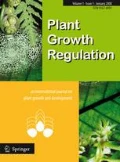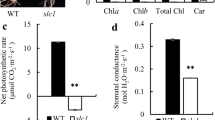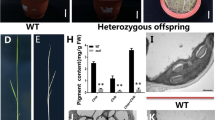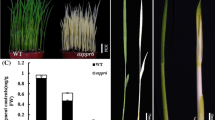Abstract
In land plants, chloroplast transcripts undergo post-transcriptional modifications, including splicing, editing, trimming, etc., before translation, and a set of nuclear-encoded proteins regulate this essential step. In this study, we characterized a rice (Oryza sativa) seedling-lethal albino mutant sla4 from the progeny of tissue culture plants of the japonica cultivar Zhonghua 11. The sla4 mutant exhibited an albino phenotype from germination through the third-leaf stage, and then gradually died. The sla4 mutants lacked photosynthetic pigments and had severe defects in photosynthesis and early chloroplast development. Map-based cloning showed that a 13-bp deletion in the coding region of OsSLA4 on chromosome 7 resulted in the albino phenotype and albino mutants were also generated by knocking-out OsSLA4 in wild type with the CRISPR/Cas9 system. OsSLA4 encodes a chloroplast-localized pentatricopeptide repeat (PPR) protein with 15 PPR motifs and an atypical DYW-like motif. Loss-of-function of OsSLA4 resulted in severe defects in the intron splicing of atpF, ndhA, petB, rpl2, rpl16, rps12-2, and trnG, as well as a significant reduction in the transcript levels of chloroplast ribosomal RNAs and some chloroplast development- and photosynthesis-related genes. These results indicate that OsSLA4 is indispensable for early chloroplast development and seedling growth in rice, most likely acting by influencing the intron splicing of multiple chloroplast group II introns.









Similar content being viewed by others
References
Aryamanesh N, Ruwe H, Sanglard LVP, Eshraghi L, Bussell JD, Howell KA, Small ID, Francs-Small CC (2017) The pentatricopeptide repeat protein EMB2654 is essential for trans-splicing of a chloroplast small ribosomal subunit transcript. Plant Physiol 173:1164–1176
Asakura Y, Bayraktar OA, Barkan A (2008) Two CRM protein subfamilies cooperate in the splicing of group IIB introns in chloroplasts. RNA 14:2319–2332
Asano T, Miyao A, Hirochika H, Kikuchi S, Kadowaki K (2013) A pentatricopeptide repeat gene of rice is required for splicing of chloroplast transcripts and RNA editing of ndhA. Plant Biotechnol 30:57–64
Barkan A, Small I (2014) Pentatricopeptide repeat proteins in plants. Annu Rev Plant Biol 65:415–442
Corneille S, Lutz K, Maliga P (2000) Conservation of RNA editing between rice and maize plastids: are most editing events dispensable? Mol Gen Genet 264:419–424
Cushing DA, Forsthoefel NR, Gestaut DR, Vernon DM (2005) Arabidopsis emb175 and other ppr knockout mutants reveal essential roles for pentatricopeptide repeat (PPR) proteins in plant embryogenesis. Planta 221:424–436
de Longevialle AF, Small ID, Lurin C (2010) Nuclearly encoded splicing factors implicated in RNA splicing in higher plant organelles. Mol Plant 3:691–705
Forsthoefel NR, Wu YW, Schulz B, Bennett MJ, Feldmann KA (1992) T-DNA insertion mutagenesis in Arabidopsis : prospects and perspectives. Aust J Plant Physiol 19:353–366
Fujii S, Small I (2011) The evolution of RNA editing and pentatricopeptide repeat genes. New Phytol 191:37–47
Germain A, Hotto AM, Barkan A, Stern DB (2013) RNA processing and decay in plastids. Wires RNA 4:295–316
Gothandam KM, Kim ES, Cho HJ, Chung YY (2005) OsPPR1, a pentatricopeptide repeat protein of rice is essential for the chloroplast biogenesis. Plant Mol Biol 58:421–433
Hajdukiewicz PTJ, Allison LA, Maliga P (1997) The two RNA polymerases encoded by the nuclear and the plastid compartments transcribe distinct groups of genes in tobacco plastids. EMBO J 16:4041–4048
Hammani K, Barkan A (2014) An mTERF domain protein functions in group II intron splicing in maize chloroplasts. Nucleic Acids Res 42:5033–5042
Hammani K, Takenaka M, Miranda R, Barkan A (2016) A PPR protein in the PLS subfamily stabilizes the 5′-end of processed rpl16 mRNAs in maize chloroplasts. Nucleic Acids Res 44:4278–4288
Harris EH, Boynton JE, Gillham NW (1994) Chloroplast ribosomes and protein synthesis. Microbiol Rev 58:700–754
Hashimoto M, Endo T, Peltier G, Tasaka M, Shikanai T (2003) A nucleus-encoded factor, CRR2, is essential for the expression of chloroplast ndhB in Arabidopsis. Plant J 36:541–549
Hiei Y, Komari T (2008) Agrobacterium-mediated transformation of rice using immature embryos or calli induced from mature seed. Nat Protoc 3:824–834
Inada M, Sasaki T, Yukawa M, Tsudzuki T, Sugiura M (2004) A systematic search for RNA editing sites in pea chloroplasts: an editing event causes diversification from the evolutionarily conserved amino acid sequence. Plant Cell Physiol 45:1615–1622
Jarvis P, Lopez-Juez E (2013) Biogenesis and homeostasis of chloroplasts and other plastids. Nat Rev Mol Cell Biol 14:787–802
Jenkins BD, Barkan A (2001) Recruitment of a peptidyl-tRNA hydrolase as a facilitator of group II intron splicing in chloroplasts. EMBO J 20:872–879
Jenkins BD, Kulhanek DJ, Barkan A (1997) Nuclear mutations that block group II RNA splicing in maize chloroplasts reveal several intron classes with distinct requirements for splicing factors. Plant Cell 9:283–296
Khrouchtchova A, Monde RA, Barkan A (2012) A short PPR protein required for the splicing of specific group II introns in angiosperm chloroplasts. RNA 18:1197–1209
Kumar S, Stecher G, Tamura K (2016) MEGA7: molecular evolutionary genetics analysis version 7.0 for bigger datasets. Mol Biol Evol 33:1870–1874
Lichtenthaler HK (1987) Chlorophylls and carotenoids: pigments of photosynthetic biomembranes. Method Enzymol 148:350–382
Liere K, Börner T (2007) Transcription and transcriptional regulation in plastids. In: Bock R (ed) Cell and molecular biology of plastids. Springer, Berlin, pp 121–174
Lin DZ, Gong XD, Jiang Q, Zheng KL, Zhou H, Xu JL, Teng S, Dong YJ (2015) The rice ALS3 encoding a novel pentatricopeptide repeat protein is required for chloroplast development and seedling growth. Rice 8:17
Liu WZ, Fu YP, Hu GC, Si HM, Zhu L, Wu C, Sun ZX (2007) Identification and fine mapping of a thermo-sensitive chlorophyll deficient mutant in rice (Oryza sativa L.). Planta 226:785–795
Liu C, Zhu H, Xing Y, Tan J, Chen X, Zhang J, Peng H, Xie Q, Zhang Z (2016) Albino Leaf 2 is involved in the splicing of chloroplast group I and II introns in rice. J Exp Bot 67:5339–5347
Livak KJ, Schmittgen TD (2001) Analysis of relative gene expression data using real-time quantitative PCR and the 2– ∆∆CT method. Methods 25:402–408
Lurin C, Andrés C, Aubourg S, Bellaoui M, Bitton F, Bruyère C, Caboche M, Debast C, Gualberto J, Hoffmann B, Lecharny A, Ret ML, Martin-Magniette ML, Mireau H, Peeters N, Renou JP, Szurek B, Taconnat L, Small I (2004) Genome-wide analysis of Arabidopsis pentatricopeptide repeat proteins reveals their essential role in organelle biogenesis. Plant Cell 16:2089–2103
Ma XL, Zhang QY, Zhu QL, Liu W, Chen Y, Qiu R, Wang B, Yang ZF, Li HY, Lin YR, Xie YY, Shen RX, Chen SF, Wang Z, Chen YL, Guo JX, Chen LT, Zhao XC, Dong ZC, Liu YG (2015) A robust CRISPR/Cas9 system for convenient, high-efficiency multiplex genome editing in monocot and dicot plants. Mol Plant 8:1274–1284
Marin-Navarro J, Manuell AL, Wu J, Mayfield SP (2007) Chloroplast translation regulation. Photosynth Res 94:359–374
Michel F, Kazuhiko U, Haruo O (1989) Comparative and functional anatomy of group II catalytic introns-a review. Gene 82:5–30
Neuhaus HE, Emes MJ (2000) Nonphotosynthetic metabolism in plastids. Annu Rev Plant Phys 51:111–140
O’Toole N, Hattori M, Andres C, Iida K, Lurin C, Schmitz-Linneweber C, Sugita M, Small I (2008) On the expansion of the pentatricopeptide repeat gene family in plants. Mol Biol Evol 25:1120–1128
Okuda K, Chateigner-Boutin AL, Nakamura T, Delannoy E, Sugita M, Myouga F, Motohashi R, Shinozaki K, Small I, Shikanai T (2009) Pentatricopeptide repeat proteins with the DYW motif have distinct molecular functions in RNA editing and RNA cleavage in Arabidopsis chloroplasts. Plant Cell 21:146–156
Ostheimer GJ, Williams-Carrier R, Belcher S, Osborne E, Gierke J, Barkan A (2003) Group II intron splicing factors derived by diversification of an ancient RNA-binding domain. EMBO J 22:3919–3929
Schallenberg-Rudinger M, Knoop V (2016) Coevolution of organelle RNA editing and nuclear specificity factors in early land plants. Adv Bot Res 78:37–93
Schmitz-Linneweber C, Williams-Carrier RE, Williams-Voelker PM, Kroeger TS, Vichas A, Barkan A (2006) A pentatricopeptide repeat protein facilitates the trans-splicing of the maize chloroplast rps12 pre-mRNA. Plant Cell 18:2650–2663
Shen YJ, Jiang H, Jin JP, Zhang ZB, Xi B, He YY, Wang G, Wang C, Qian L, Li X, Yu QB, Liu HJ, Chen DH, Gao JH, Huang H, Shi TL, Yang ZN (2004) Development of genome-wide DNA polymorphism database for map-based cloning of rice genes. Plant Physiol 135:1198–1205
Small ID, Peeters N (2000) The PPR motif-a TPR-related motif prevalent in plant organellar proteins. Trends Biochem Sci 25:46–47
Stern DB, Goldschmidt-Clermont M, Hanson MR (2010) Chloroplast RNA metabolism. Annu Rev Plant Biol 61:125–155
Sun HZ, Peng T, Zhang J, Li JZ, Du YX, Zhao QZ (2017) Test of small RNA sequencing repeatability in rice. Rice Sci 24:56–60
Tan JJ, Tan ZH, Wu FQ, Sheng PK, Heng YQ, Wang XH, Ren YL, Wang JL, Guo XP, Zhang X, Cheng ZJ, Jiang L, Liu XN, Wang HY, Wan JM (2014) A novel chloroplast-localized pentatricopeptide repeat protein involved in splicing affects chloroplast development and abiotic stress response in rice. Mol Plant 7:1329–1349
Till B, Schmitz-Linneweber C, Williams-Carrier R, Barkan A (2001) CRS1 is a novel group II intron splicing factor that was derived from a domain of ancient origin. RNA 7:1227–1238
Toda T, Fujii S, Noguchi K, Kazama T, Toriyama K (2012) Rice MPR25 encodes a pentatricopeptide repeat protein and is essential for RNA editing of nad5 transcripts in mitochondria. Plant J 72:450–460
Wang JL, Jiang JD, Oard JH (2000) Structure, expression and promoter activity of two polyubiquitin genes from rice (Oryza sativa L.). Plant Sci 156:201–211
Wang DK, Liu HQ, Zhai GW, Wang LS, Shao JF, Tao YZ (2016a) OspTAC2 encodes a pentatricopeptide repeat protein and regulates rice chloroplast development. J Genet Genom 43:601–608
Wang L, Xu J, Nian JQ, Shen NW, Lai KK, Hu J, Zeng DL, Ge CW, Fang YX, Zhu L, Qian Q, Zhang GH (2016b) Characterization and fine mapping of the rice gene OsARVL4 regulating leaf morphology and leaf vein development. Plant Growth Regul 78:345–356
Wang ZW, Zhang TQ, Xing YD, Zeng XQ, Wang L, Liu ZX, Shi JQ, Zhu XY, Ma L, Li YF, Ling YH, Sang XC, He GH (2016c) YGL9, encoding the putative chloroplast signal recognition particle 43 kDa protein in rice, is involved in chloroplast development. J Integr Agric 15:944–953
Watkins KP, Kroeger TS, Cooke AM, Williams-Carrier RE, Friso G, Belcher SE, van Wijk KJ, Barkan A (2007) A ribonuclease III domain protein functions in group II intron splicing in maize chloroplasts. Plant Cell 19:2606–2623
Williams PM, Barkan A (2003) A chloroplast-localized PPR protein required for plastid ribosome accumulation. Plant J 36:675–686
Xie KB, Minkenberg B, Yang YN (2015) Boosting CRISPR/Cas9 multiplex editing capability with the endogenous tRNA-processing system. Proc Natl Acad Sci USA 112:3570–3575
Xu X, Zhang XB, Shi YF, Wang HM, Feng BH, Li XH, Huang QN, Song LX, Guo D, He Y, Wu JL (2016) A point mutation in an F-box domain-containing protein is responsible for brown hull phenotype in rice. Rice Sci 23:1–8
Yap A, Kindgren P, des Francs-Small CC, Kazama T, Tanz SK, Toriyama K, Small I (2015) AEF1/MPR25 is implicated in RNA editing of plastid atpF and mitochondrial nad5, and also promotes atpF splicing in Arabidopsis and rice. Plant J 81:661–669
Ye JW, Gong ZY, Chen CG, Mi HL, Chen GY (2012) A mutation of OSOTP 51 leads to impairment of photosystem I complex assembly and serious photo-damage in rice. J Integr Plant Biol 54:87–98
Yu HP, Qiu ZN, Xu QK, Wang ZW, Zeng DL, Hu J, Zhang GH, Zhu L, Gao ZY, Cheng G, Guo LB, Qian Q, Ren DY (2017) Fine mapping of LOW TILLER 1, a gene controlling tillering and panicle branching in rice. Plant Growth Regul 83:93–104
Zhang Y, Su JB, Duan S, Ao Y, Dai JR, Liu J, Wang P, Li YG, Liu B, Feng DR, Wang JF, Wang HB (2011) A highly efficient rice green tissue protoplast system for transient gene expression and studying light/chloroplast-related processes. Plant Methods 7:30
Zhang ZG, Cui XA, Wang YW, Wu JX, Gu XF, Lu TG (2017) The RNA editing factor WSP1 is essential for chloroplast development in rice. Mol Plant 10:86–98
Acknowledgements
This study was supported by the National Natural Science Foundation of China (Grant Nos. 31701390, 31461143014, 31661143006, 91535205), the National Key Research and Development Program of China (Grant No. 2016YFD0100902-07), Zhejiang Provincial Natural Science Foundation of China (Grant No. LY18C130007).
Author information
Authors and Affiliations
Corresponding authors
Ethics declarations
Conflict of interest
The authors declare no potential competing interests.
Electronic supplementary material
Below is the link to the electronic supplementary material.
Rights and permissions
About this article
Cite this article
Wang, Zw., Lv, J., Xie, Sz. et al. OsSLA4 encodes a pentatricopeptide repeat protein essential for early chloroplast development and seedling growth in rice. Plant Growth Regul 84, 249–260 (2018). https://doi.org/10.1007/s10725-017-0336-6
Received:
Accepted:
Published:
Issue Date:
DOI: https://doi.org/10.1007/s10725-017-0336-6




